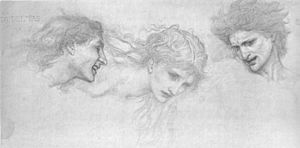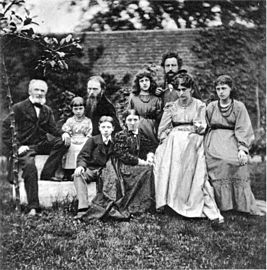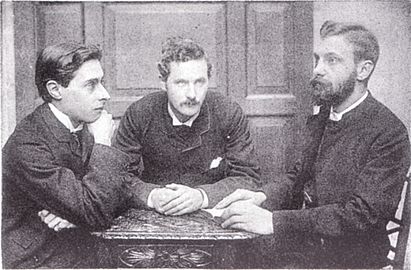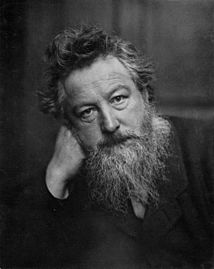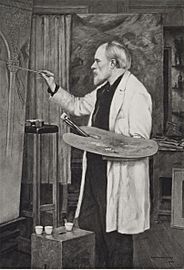Frederick Hollyer facts for kids
Quick facts for kids
Frederick Hollyer
|
|
|---|---|
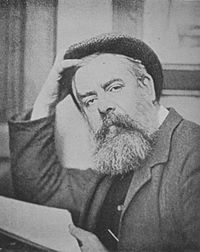
Hollyer, platinotype self-portrait, c. 1890
|
|
| Born | 17 June 1838 Pentonville, England
|
| Died | 21 November 1933 (aged 95) Blewbury, England
|
| Known for | Photography |
Frederick Hollyer (born June 17, 1838 – died November 21, 1933) was a talented English photographer. He was also an engraver, someone who carves designs onto metal plates to make prints. Hollyer was famous for taking photos of paintings and drawings. He especially loved the art of the Pre-Raphaelite Brotherhood, a group of artists. He also took many portraits of famous writers and artists in London during the late Victorian and Edwardian times.
Contents
Hollyer's Family and Early Work
Frederick Hollyer was the youngest son in his family. His father, Samuel Hollyer (1797–1883), was also an engraver. He published fine art and collected watercolour paintings. Frederick's brothers, Christopher Charles Hollyer and Samuel Hollyer Jr., also worked as engravers. Frederick's first published works were mezzotint engravings. These were prints he made from two paintings by Edwin Landseer in 1869.
Frederick Hollyer's Photography Career
Hollyer became very interested in photography around 1860. He used different printing methods for his photos. These included albumen and carbon prints. However, his favorite method was the platinotype, also known as a platinum print. People admired this process because the photos lasted a very long time. They also had a beautiful range of tones, from light to dark.
Photographing Famous Artworks
In the 1870s, Hollyer started photographing paintings and drawings. He did this with the help of Frederic Leighton, a famous artist. Hollyer photographed the works of many well-known artists. These included Edward Burne-Jones, George Frederic Watts, Simeon Solomon, and Dante Gabriel Rossetti.
The Times newspaper once wrote about his work with the Pre-Raphaelite artists. They said he helped make their art popular by reproducing it. His studio in Pembroke Square, Kensington, became a popular place for people interested in art. He worked very closely with artists like Burne-Jones and Watts. He would photograph their art as they created it. These photos sometimes even helped the artists decide on changes.
Hollyer's photos of drawings were especially good. They were printed on high-quality paper. Sometimes, people even thought they were the original drawings! One very popular photo was of three heads drawn by Burne-Jones for a work called The Masque of Cupid.
Capturing People and Places
Hollyer also took many studio portraits of people. He was also good at taking photos of the inside and outside of houses. For 30 years, he set aside Mondays for portrait photography at his studio. Many famous people came to him for their pictures. These included artists like Walter Crane, William Morris, G. F. Watts, and Burne-Jones. Writers like John Ruskin, H. G. Wells, and George Bernard Shaw also sat for him. Even famous actresses like Mrs Patrick Campbell and Ellen Terry had their portraits taken.
Hollyer didn't like the stiff, formal poses that were common in photos back then. In an interview in 1899, he shared his ideas. He believed photographers needed to study art and culture. He said photographers should learn how people's hands naturally rest. He also thought they should know how to best light a person's face. Hollyer encouraged photographers to take photos for fun, not just for money. He believed this would help photography become a true art form.
Photography as Fine Art
Frederick Hollyer played a big part in making photography seen as a fine art. His work was highly praised during his lifetime. In 1897, a critic in The Studio magazine wrote about how perfect his photos were. They joked that Hollyer should show a bad photo sometimes, just to make it easier for critics to find something to say!
Hollyer joined the Royal Photographic Society in 1865. He became a Fellow in 1895. He was also part of The Linked Ring, a group that supported artistic photography. He was a founder of the Professional Photographers' Association in 1901.
Later Life and Legacy
Frederick Hollyer married Mary Anne Armstrong (1838–1913). Their oldest son, Frederick Thomas Hollyer (1870–1952), worked with his father. He took over the photography studio when his father retired in 1913. Frederick Hollyer passed away on November 21, 1933, at the age of 95. He died at his son's home in Blewbury.
Today, Frederick Hollyer is mostly remembered for his amazing photographs. These include pictures of Burne-Jones, William Morris, and their artistic friends.
Gallery


